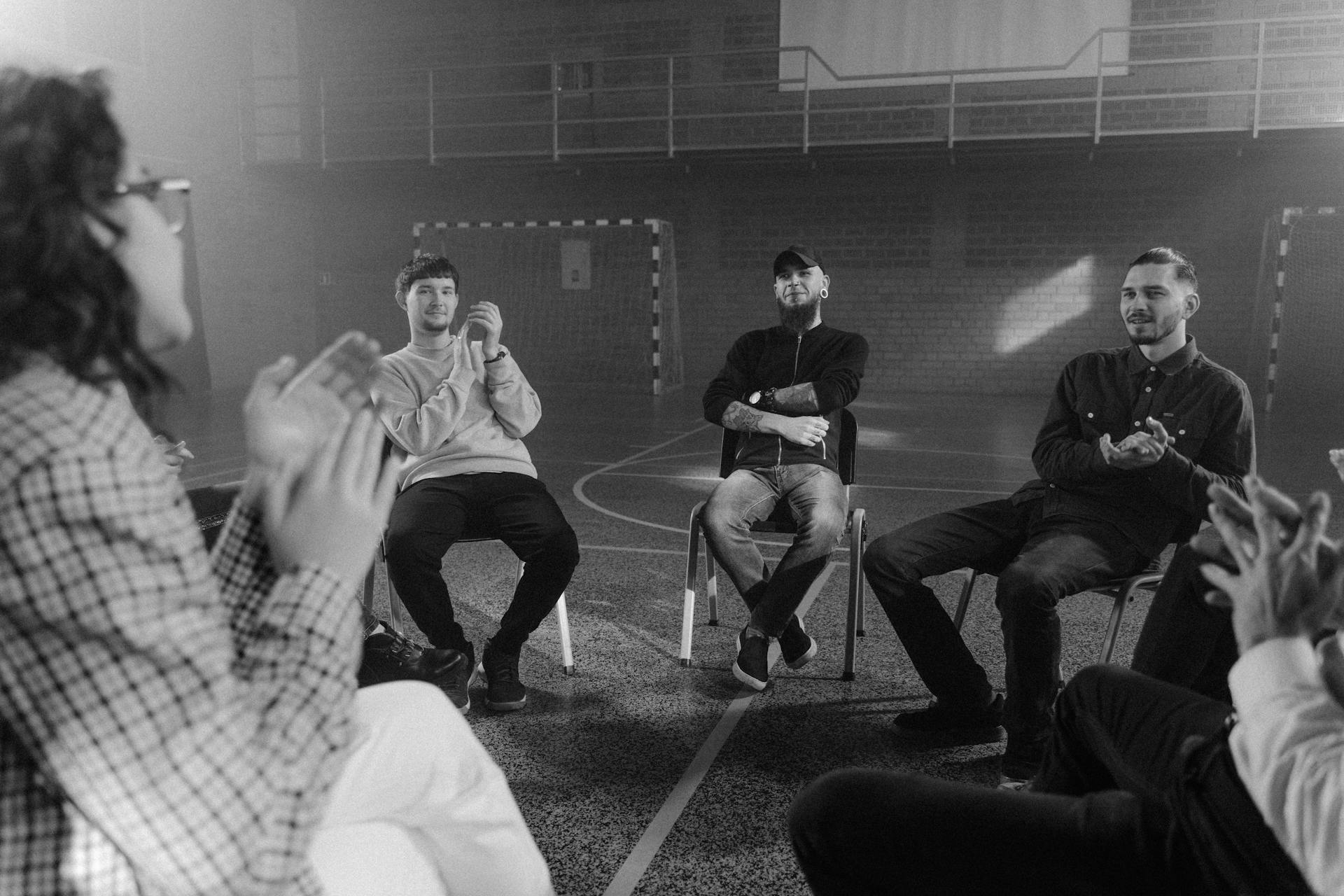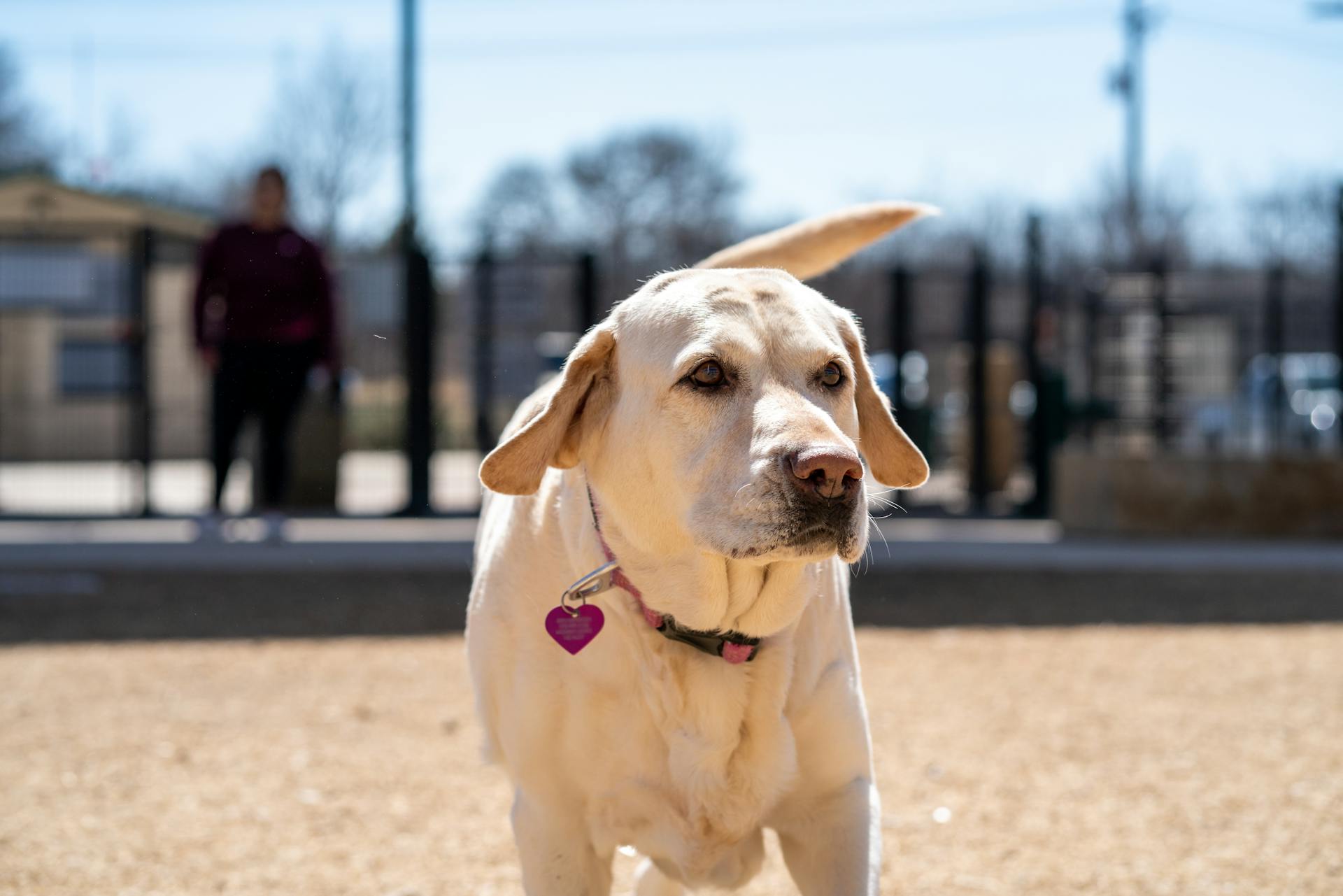
As a pet owner or trainer, choosing the right muzzle for your furry friend can be a daunting task. There are many types of muzzles available, each designed for specific purposes and breeds.
A well-fitting muzzle is essential for your pet's comfort and safety. According to our article, a muzzle that fits too loosely can cause your pet to pull it off, while one that fits too tightly can be uncomfortable and even lead to respiratory problems.
The size and shape of your pet's snout will determine the best muzzle type for them. For example, a short-nosed breed like a Pug may require a muzzle with a shorter nose opening, while a long-nosed breed like a Greyhound may require a muzzle with a longer nose opening.
Check this out: Animal Nose
Why Animal Muzzles are Controversial
Dog muzzles can look intimidating, but they're not always a bad thing. They have an unfair association with "aggressive" dogs or "attack" dogs, but most experts agree they're a necessary tool in certain situations.
The risk of a dog bite increases significantly when a dog is in severe pain or injured. Dogs can bite when you try to transport them or treat their wounds, even if they're normally well-behaved.
Dog owners need to understand when and how to use a muzzle on their dog. It's not just about preventing bites, but also about keeping both the dog and the person safe.
Every dog should learn to tolerate and accept wearing a muzzle, so if the need arises, you and your dog won't be stressed.
Using Animal Muzzles
Using a dog muzzle can be a lifesaver in certain situations. A muzzle is safe and appropriate when your dog is aggressive and has bitten another dog or a person in the past.
If your dog has a history of biting, a muzzle can provide a temporary solution to keep everyone safe while you work on behavior modification. You should always aim to change your dog's behavior and mindset with the help of an animal behaviorist, veterinarian, and/or dog trainer.
Using a muzzle doesn't solve the problem, it simply helps prevent bites while you work on changing your dog's behavior. The muzzle is not a substitute for proper training and behavior modification.
Even if your dog has no bite history, a muzzle can provide additional peace of mind if you think the risk of a dog bite exists, such as if your dog lunges and barks at other dogs or people.
Biting and Threatening Situations
If your dog has bitten another dog or a person in the past, a muzzle can be used for safety. Even if your dog has no bite history, if you think the risk of a dog bite exists, a muzzle can provide additional peace of mind. The muzzle doesn't solve the problem, it simply helps keep everybody safe while you work on behavior modification with an animal behaviorist, veterinarian, and/or dog trainer.
Your goal should be to change your dog's behavior and mindset. A muzzle can be a temporary tool to help you achieve that goal. Behavior modification is key to a long-term resolution.
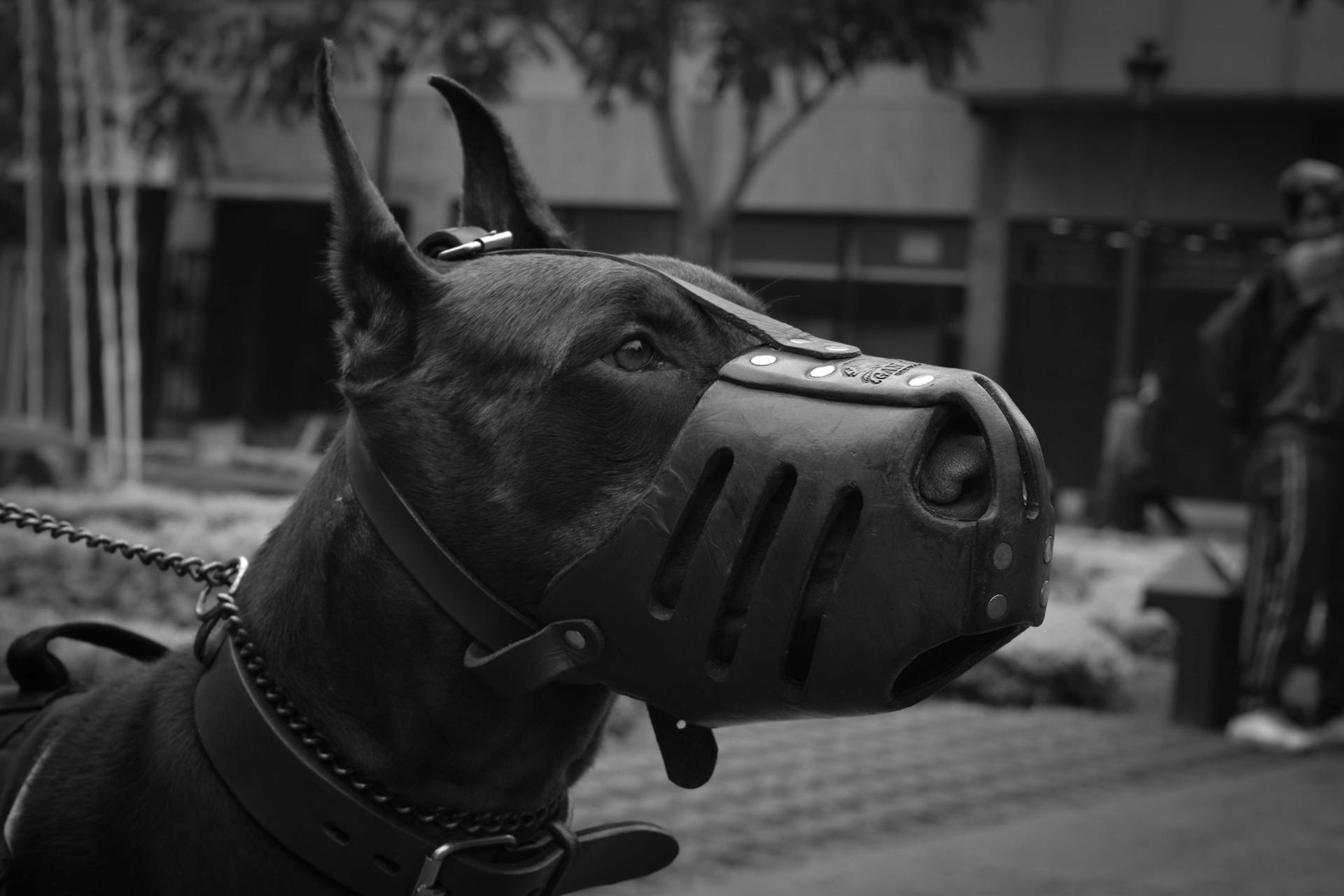
There may be specific situations that upset or stress your dog, such as examinations at the veterinarian. In these situations, a muzzle can be a lifesaver. It's a sign that behavior modification is in order.
A muzzle is safe and appropriate in situations where there's a risk of biting due to a threatening situation. This can include vet visits, where a muzzle can help prevent biting during stressful exams.
Grooming and Safety
Many dogs will tolerate or even enjoy grooming procedures like bathing or nail trimming when properly desensitized with handling exercises.
Some dogs may not be familiar with the groomer, so a muzzle can be helpful during training.
A muzzle can be especially useful during grooming sessions when the dog is not yet comfortable with the groomer.
Most dogs will start to enjoy grooming procedures like bathing or nail trimming if they're introduced to them from puppyhood.
Breed-Specific Legislation
Some states or provinces have breed-specific legislation (BSL), which requires certain breeds to wear a muzzle when not on private property.
Unfortunately, this legislation can be a challenge for dog owners and their pets.
Breed-specific legislation targets so-called "dangerous breeds."
The American Kennel Club (AKC) has spoken out against BSL and is working to offer alternatives.
Types of Animal Muzzles
There are several types of dog muzzles, each with its own unique characteristics and uses. Plastic basket muzzles are a popular choice for protection, fit, and training because they allow dogs to breathe, pant, and drink water.
Leather muzzles are another option, but it's essential to choose the basket style to ensure your dog can pant, drink, and receive treats. Leather muzzles can often be customized to fit your dog's muzzle perfectly.
Grooming muzzles, made of mesh or fabric, are only recommended for brief medical procedures, such as vaccinations, because they restrict a dog's ability to pant, drink, or eat treats.
Metal basket muzzles are often recommended for shepherd-type dogs with elongated muzzles. They offer the same benefits as plastic basket muzzles but are better suited for certain breeds.
In an emergency, you can create a makeshift muzzle using gauze, a leash, or rope. This should be a last resort, however, as it may not provide the same level of comfort and safety as a properly designed muzzle.
Here are the main types of dog muzzles:
- Plastic basket muzzle
- Leather muzzle (basket style)
- Grooming (mesh or fabric) muzzle
- Metal basket muzzle
- Emergency muzzle (gauze, leash, or rope)
A Guide to Choosing
Choosing the right muzzle for your dog is crucial, and it's not just about picking any old one off the shelf. The right fit is key to using a muzzle correctly, and too loose or too tight can be a problem.
To ensure a proper fit, you should be able to fit just one finger between your dog's head and the strap. It's also a good idea to try on various sizes and get input from a knowledgeable professional trainer or experienced muzzle user.
Measurements are especially important when ordering online, and even flat-faced dogs like Pugs can wear a muzzle, although a custom-fitted option may be the best solution.
When shopping for a muzzle, consider the intended use, such as short-term wear for vet trips or longer walks. Jennifer Malawey, a certified professional dog trainer, recommends finding a muzzle that allows your dog to breathe, pant, drink water, and accept treats comfortably.
Explore further: Dog Wear
A muzzle that restricts your dog's ability to do these things is not suitable for extended wear. Look for durable materials like rubber and biothane, and consider a muzzle with adjustable straps for a better fit.
Moldable muzzles can also be a good option if you're opting for a muzzle without customization options. Snout length is another important factor, and large and small breeds will have different muzzle requirements.
Avoid one-size-fits-all muzzles, and instead look for ones that cater to your dog's specific needs. With the right muzzle, you can help keep your dog safe and happy.
Intriguing read: Animals That Look like Dogs
Product Reviews and Recommendations
If you're in the market for a dog muzzle, there are several great options to consider. The Baskerville Ultra Muzzle is a top pick for overall comfort and versatility.
This muzzle is designed for long-term use, making it ideal for protection, training, and grooming. It's a great choice for dogs that need to be muzzled frequently.
For shorter visits to the vet or groomer, the Coastal Pet Products Best Fit Adjustable Muzzle is a great option. It's designed to fit most dogs comfortably and securely.
If you have a dog with a short snout, the Trust Your Dog Muzzle is a custom-made solution that's tailored to their unique dimensions.
Top Picks
If you're in the market for a dog muzzle, there are several top picks to consider.
The Baskerville Ultra Muzzle is a great all-around choice, designed for long-term comfort and suitable for protection, training, and grooming.
The Coastal Pet Products Best Fit Adjustable Muzzle is ideal for short vet or grooming visits, and will fit most dogs.
If you have a dog with a short snout, the Trust Your Dog Muzzle is a custom-made option that's designed to fit their unique dimensions.
For a truly personalized fit, the Bumas Muzzle is made from high-tech biothane webbing and tailored to a dog's snout size, shape, and personality.
How We Selected

We consulted with a team of experts to help us make informed decisions about the dog muzzles we recommend. This team included Michael Shikashio, a certified animal behaviorist and dog aggression expert, and Dr. Katherine Houpt, a veterinary behaviorist and professor emeritus of behavior medicine at Cornell University's College of Veterinary Medicine.
We also sought advice from Jennifer Malawey, a certified dog trainer and behavioral consultant, and Laura Sharkey, owner and senior trainer at Woofs! Dog Training Center. Reporter Shoshi Parks' experience as a certified professional dog trainer added valuable insights to our selection process.
Our experts helped us identify key characteristics to look for in a dog muzzle. These characteristics include breathability, allowing the dog to pant, eat treats, and drink water.
We favored products that are moldable or have a custom fit to ensure a comfortable and secure fit for the dog. The type of material used is also important, as it affects the dog's comfort and safety.
To ensure the muzzle stays in place, we looked for products with secure straps and optional safety straps. We also preferred products that come in multiple sizes and colors to cater to different breeds and personal preferences.
Safety and Design Considerations
When designing an animal muzzle, it's essential to prioritize safety and comfort for the animal. A well-designed muzzle can prevent injuries and stress for both the animal and the handler.
The muzzle should be made from durable, non-toxic materials that can withstand biting and chewing. In fact, many animal muzzles are made from nylon or rubber, which are both easy to clean and resistant to wear and tear.
A good muzzle should also be adjustable to accommodate different head sizes and shapes. This is especially important for animals with unique features, such as a brachycephalic (short-nosed) breed.
The muzzle should be designed to allow for proper breathing and visibility. This means leaving a small gap between the nose and the muzzle to prevent respiratory distress.
The muzzle should be securely fastened to prevent it from coming loose during use. This can be achieved through the use of straps, Velcro, or other secure fastening systems.
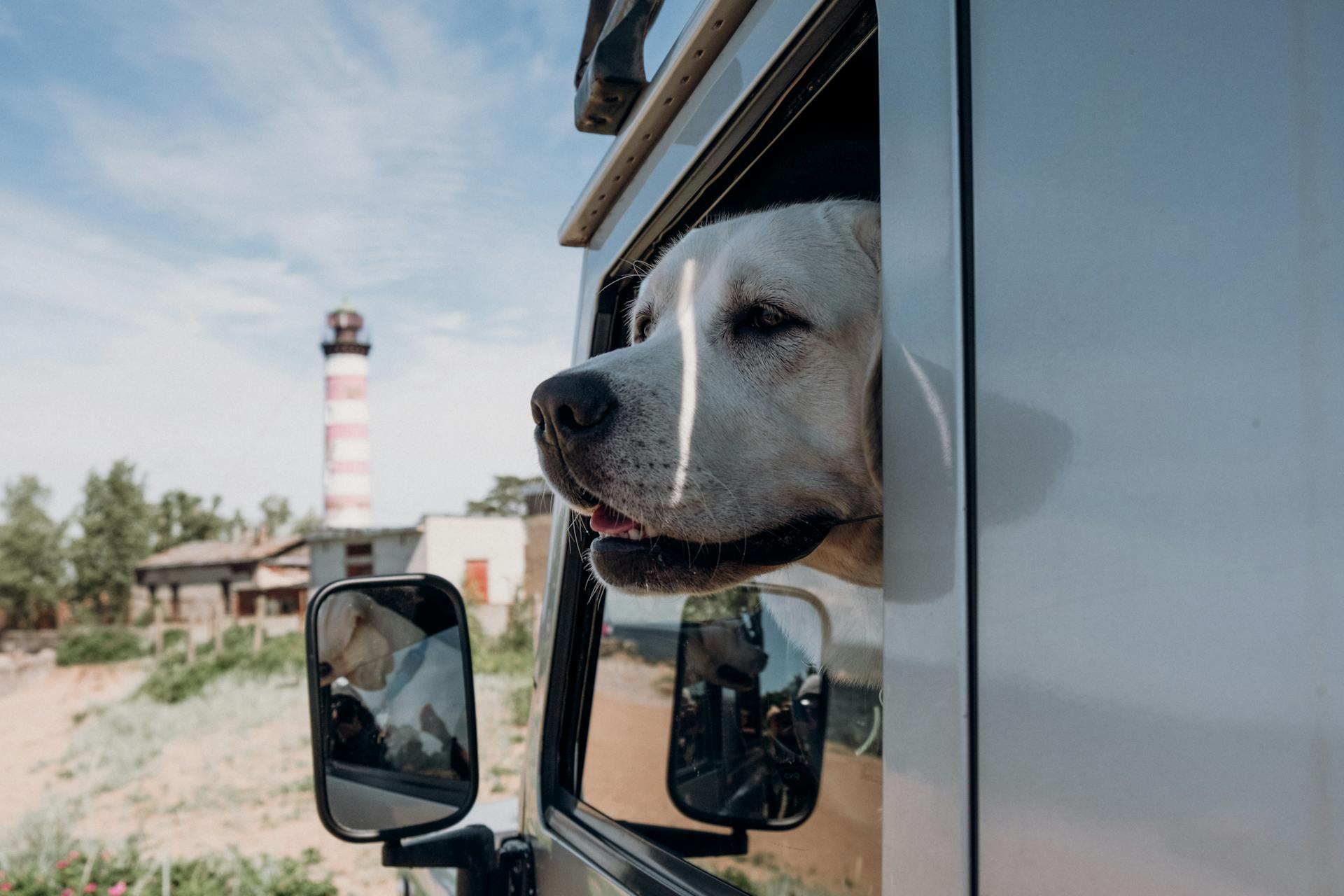
An animal muzzle should not obstruct the animal's vision or hearing. In fact, many muzzles are designed with a clear plastic or mesh panel to allow for unobstructed vision and hearing.
A muzzle can be a valuable tool for training and socialization, but it should be used sparingly and under the guidance of a professional trainer.
Reasons for Using Animal Muzzles
Using an animal muzzle is a responsible decision, especially when you want to ensure everyone's safety. A muzzle can be a lifesaver in situations where your dog might feel stressed or anxious.
All dogs have a bite threshold, the point at which they're stressed enough to bite. This threshold may be reached easily or take many stressful triggers to get to that point.
A muzzle is beneficial for safely handling a fearful or injured dog. This is especially true when you need to do a medical exam or groom a dog who is likely to bite.
You can use a muzzle to prevent injury to people or other animals in various scenarios. For example, introducing your dog to a new person, introducing your dog to another dog, or going for a walk where there might be off-leash dogs who approach.
A muzzle can be a wonderful tool to show you are being responsible. By using a muzzle, you can then try to educate people about the dangers of allowing their dogs or kids to approach dogs they don’t know.
Here are some common scenarios where a muzzle is recommended:
- To safely handle a fearful or injured dog
- To safely do a medical exam or groom a dog who is likely to bite
- To prevent injury to people or other animals in a variety of scenarios
To get the most out of your muzzle, make sure to fit it appropriately, so you can enter these situations without worrying about it slipping off and your dog biting.
Teaching and Training
Teaching and training your dog to wear a muzzle requires patience, consistency, and positive reinforcement. It's essential to introduce the muzzle under low-stress conditions, with a step-by-step process, and with appropriate rewards.
To start, sit in a chair with a clicker and put the muzzle between your knees with the opening facing the dog. Remain still during this process, eyes looking at the muzzle and not making any noises. When your dog touches their nose to the muzzle, mark this behavior with a click or a "yes" and then give a high-value treat.
The goal is to have your dog comfortably wear the muzzle, and to achieve this, you can use the following steps:
- Start with them touching their nose to the muzzle.
- Move to a nose going in before you mark, then a full snout before you mark.
- When your dog is consistently putting their entire snout in the muzzle, you can add the cue "muzzle up" or another cue of your choice exclusive to this.
Remember to always build up the duration they can comfortably wear the muzzle, and to avoid removing the muzzle if the dog is fussing. With patience and consistency, your dog will learn to accept the muzzle and associate it with positive experiences.
Teaching Your
Teaching your dog to wear a muzzle requires patience, consistency, and positive reinforcement. You can start by letting them sniff the muzzle, giving a treat, and repeating the process until they're comfortable with it.
Using a clicker and treats, you can train your dog to touch their nose to the muzzle, then gradually increase the amount of their snout that goes inside. As they become more comfortable, you can add the cue "muzzle up" and start offering treats through the muzzle.
Here are the steps to follow:
- Start by letting your dog sniff the muzzle, giving a treat, and repeating the process.
- Use a clicker and treats to train your dog to touch their nose to the muzzle.
- Gradually increase the amount of their snout that goes inside the muzzle.
- Add the cue "muzzle up" and start offering treats through the muzzle.
- Begin to put on the straps, using peanut butter to make it more appealing.
- Practice wearing the muzzle in different locations, starting with short walks and gradually increasing the duration.
Remember, it's essential to keep the learning process positive and fun for your dog. Avoid removing the muzzle if they're fussing, as this can create a negative association. Instead, distract them with treats and remove the muzzle when they're calm.
Short-Snout: Trust Your
Trust Your Dog Muzzle is a great option for brachycephalic breeds like pugs and bulldogs.
Custom fit muzzles are essential for short-snouted dogs, and Trust Your Dog Muzzle offers two designs to choose from.
The Custom Vinyl Muzzle features holes from top to bottom for easy water and treat access, making it ideal for dogs that need to eat or drink while wearing the muzzle.
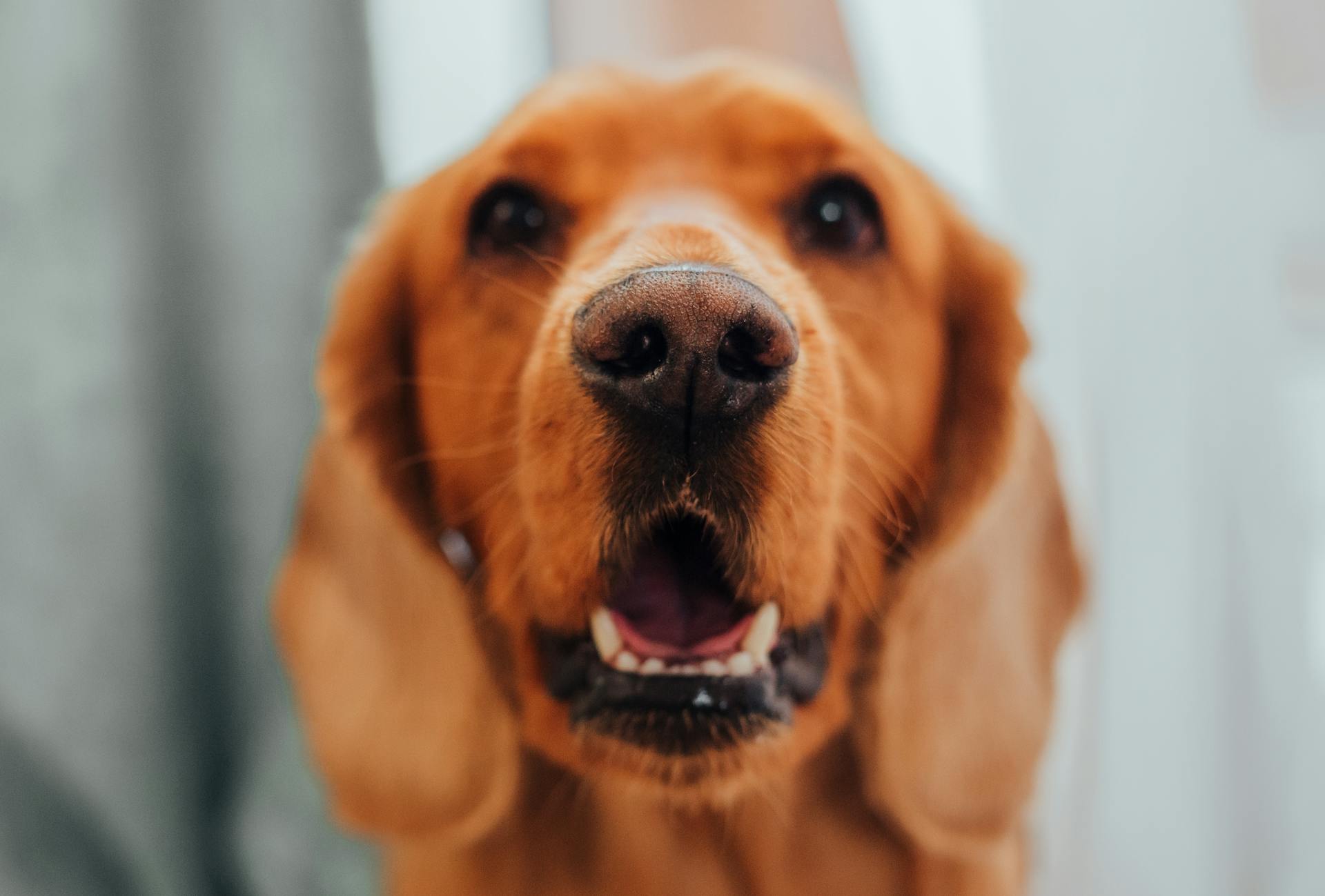
A colorful biothane strap wraps around the back of the head and secures with quick-release metal or plastic buckles.
The Custom Biothane Muzzle has straps that wrap around the back of the head and over the forehead, securing with a quick-release metal or plastic buckle.
You can customize your Trust Your Dog Muzzle with rhinestones, silver heart rivets, and brass stars.
The biothane straps come in 28 colors and can be mixed and matched to create a unique look.
Trust Your Dog Muzzle is handmade with a custom fit, but this also means it may take up to 12 weeks to arrive.
Keep in mind that these muzzles are not eligible for returns, so it's essential to choose the right size and design for your dog.
Frequently Asked Questions
Are muzzles painful to the pet?
No, muzzles are not painful to pets. They are designed to be comfortable and safe for use
Sources
- https://www.akc.org/expert-advice/training/dog-muzzles-when-why-how-to-use/
- https://k9infocus.com/a-guide-to-choosing-the-right-muzzle/
- https://www.businessinsider.com/guides/pets/best-dog-muzzle
- https://petexpertise.com/products/jafco-muzzles
- https://resources.bestfriends.org/article/dog-muzzles-how-and-why-use-them
Featured Images: pexels.com
